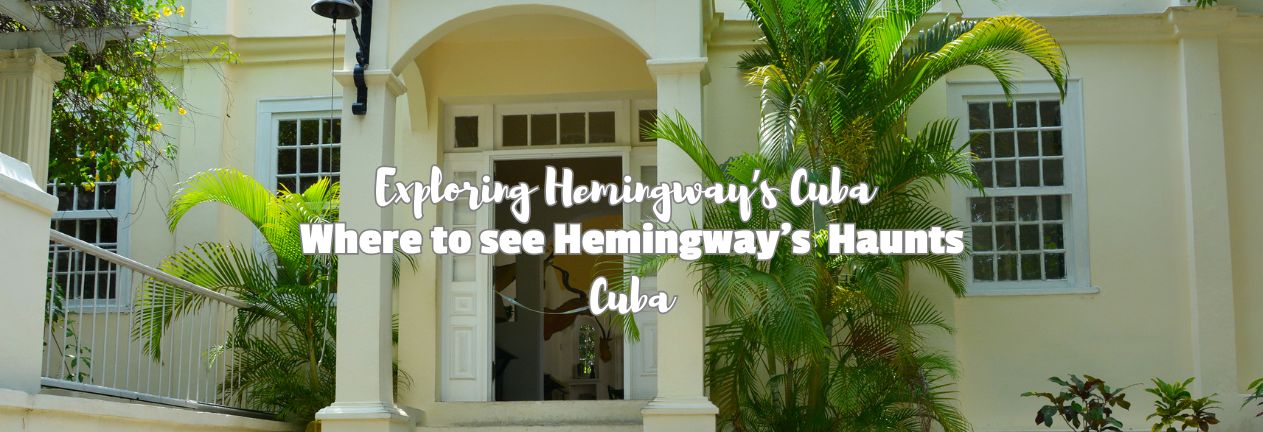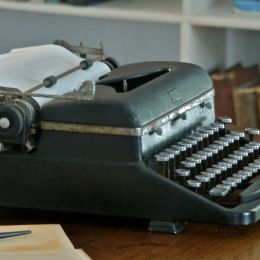The American journalist, novelist, and short-story writer, Ernest Hemingway, called Cuba home for nearly 20 years. “Papa” wrote several of his novels here, remained on good terms with the Castro government after the Cuban Revolution, and missed Cuba after he left here permanently in 1960. You’ll find many of Cuba’s cultural aspects within his novels, and there are several locations in which he lived, wrote, drank, and traveled, where you can invoke the spirit of Hemingway by visiting. Here’s our guide on how to visit Hemingway’s Cuba – how to explore the Cuba of Ernest Hemingway.
THIS POST MAY CONTAIN COMPENSATED AND AFFILIATE LINKS. MORE INFORMATION IN OUR DISCLAIMER
There are six main locations to visit around Cuba – all easy to access – where you’ll be able to explore Hemingway’s influence. I’ll cover where they are, how they’re connected to Hemingway, and the best way to visit them. Plus, of course, a reading list of his novels and their connection to Cuba.
EASIEST WAY TO VISIT
Visit the streets, bars and restaurants that the American writer used to frequent with this Hemingway’s Cuba Guided Tour – an unbeatable plan!
Hemingway and Cuba: A Brief History
Ernest Hemingway arrived in Cuba in the early 1930s and officially made it his home in 1940, settling in a hillside estate just outside Havana. He found solace in Cuba’s atmosphere — a place to fish, write, and escape the clamor of fame. It was here he penned For Whom the Bell Tolls and his Pulitzer Prize-winning novella The Old Man and the Sea, a story deeply rooted in Cuban waters and coastal life.
PRACTICAL TRAVEL TIPS
- 🛡️ Get Travel Insurance: Civitatis includes medical expenses, repatriation, theft, luggage delays. No deductibles or upfront payments. Get a quote here. .
- 🛂💻 Buy your Cuba eVisa here.
- 🔌 Be ready for the plug, socket & power situation.
- 📶 Internet, maps, data on the go. Buy an eSim for Cuba. Or pre-order a physical SIM card
- 🔒 Do NOT leave home without a VPN. Buy for your trip here.
Beyond his writing, Hemingway developed a profound bond with the Cuban people. He was both admired and embraced by locals, not just for his fame but for his humility. When he won the Nobel Prize for Literature in 1954, Hemingway famously dedicated the medal to the Cuban people, stating, “This belongs to Cuba because my work was conceived and created in Cuba.”
Key Locations of Hemingway’s Cuba
From the home that he owned just outside Havana, to the bars he frequented and where he sailed his boat, Pilar, there are key locations where the memory of Ernest Hemingway lives on, even more than 60 years after his death.
1. Finca Vigia – Lookout Farm: Hemingway’s Cuban Home
Located in the quiet suburb of San Francisco de Paula, Finca Vigía (“Lookout Farm”) was Hemingway’s home for nearly two decades. Set on a lush hilltop with panoramic views, the house remains beautifully preserved, offering a rare glimpse into the writer’s daily life.
There is a fee of 1500 CUP to enter the grounds of the property.
Visitors can’t enter the house but can peer inside through open windows and doors. His original typewriter still rests on a table, surrounded by thousands of books, animal trophies, and personal photographs. The adjacent tower, where Hemingway often wrote, and the nearby pool — once frequented by guests like Ava Gardner — remain intact. The estate also houses his beloved fishing boat, Pilar, immortalized in many of his writings.
Hemingway first rented this property in 1939 and then purchased it, with his third wife, Martha Gellhorn, in December 1940. You’ll find Finca Vigia about 7.5 miles (12 kilometers) from Old Havana, in the San Francisco de Paul district of the city. Like Hemingway’s Key West, Florida home, this house is now a museum and can be visited on a tour.
The name of the house comes from its strategic location. It was built on the site of a former Spanish Army surveillance barracks by Miguel Pascual y Baguer in 1886. There are lovely views from the terrace of Havana.
While Hemingway travelled abroad (he spent significant time during WWII working as a journalist), this was his home from 1939 until 1960, when he left Cuba for the final time. The house is colonial in style, and the interior remains largely untouched from his time here.
What can you see at Finca Vigia?
In the gardens at Finca Vigia, you’ll see Hemingway’s famous boat, Pilar. Inside the house, you’ll see his typewriter, desk, books, and personal belongings. You can’t actually go inside the house, but you can peek through the windows and see the house pretty much as he left it.
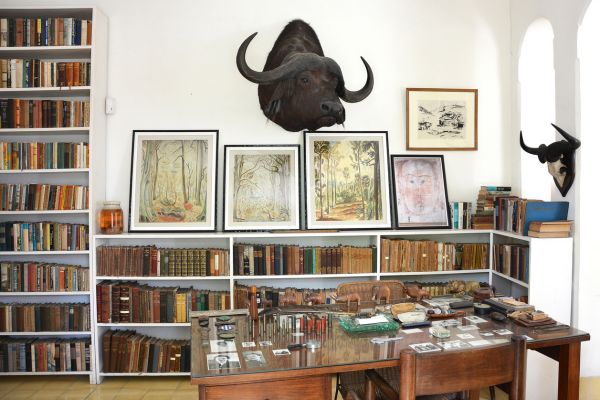
What Hemingway Wrote at Finca Vigía
Finca Vigía wasn’t just Hemingway’s refuge — it was his creative powerhouse. Surrounded by lush gardens, the quiet hum of the countryside, and the distant view of Havana, Hemingway found the focus and solitude he needed to write some of his most celebrated works.
The Old Man and the Sea (1952)
Arguably the most famous piece he wrote in Cuba, The Old Man and the Sea was completed at Finca Vigía and was deeply inspired by his fishing experiences out of Cojímar. The novella earned Hemingway the Pulitzer Prize and contributed to his Nobel Prize for Literature in 1954. It tells the story of Santiago, an aging Cuban fisherman in a relentless struggle with a giant marlin — a story that mirrors both Hemingway’s love of the sea and his reflections on aging, pride, and perseverance.
For Whom the Bell Tolls (1940)
Though much of For Whom the Bell Tolls was conceived during Hemingway’s time reporting in Spain, he revised and completed the manuscript at Finca Vigía. The novel explores war, love, and sacrifice through the lens of the Spanish Civil War. It quickly became a bestseller and cemented Hemingway’s reputation as one of America’s greatest novelists.
A Moveable Feast (published posthumously in 1964)
While the memoir focuses on Hemingway’s early years in Paris, much of it was compiled and edited during his time at Finca Vigía. Surrounded by his notebooks and memories, he revisited his youthful adventures with a bittersweet clarity. The result is a beautifully reflective work that has become one of his most beloved books.
Other Works and Projects
Hemingway was prolific at Finca Vigía, working on various projects and stories, many of which remained unpublished during his lifetime. He wrote letters, edited manuscripts, and jotted down ideas from the tower of his estate. The quiet routine of life in Cuba — fishing in the mornings, writing until noon, socializing or resting in the afternoons — became a rhythm that fueled his creativity.
Finca Vigía, then, is not just a preserved home — it’s the place where literary history was made, page by page.
How to get to Finca Vigia from Havana
It takes about 30 minutes to go from Old Havana’s Central Park. You can use La Nave (one of the apps that we recommend to estimate taxi prices) to get there. At a rough estimate, you’re looking at it costing just over 5,000 CUP to get there. If you’re using La Nave you’ll need to pay in Cuban pesos.
Alternatively, you can take a bus. Take the P7 bus from Parque El Curita in Central Havana, which leaves from the first bus stop. You’ll pay 2 CUP for the bus ride. It’s about a 25-minute ride.
2. Hotel Ambos Mundos and Hemingway
Before settling into Finca Vigía, Ernest Hemingway spent significant time in Hotel Ambos Mundos, a pink, five-story colonial hotel in the heart of Old Havana. It was here, in Room 511, that Hemingway stayed throughout the 1930s and began drafting what would become For Whom the Bell Tolls.
The room — now a small museum — has been preserved with Hemingway’s typewriter, a bookshelf, and period furnishings, offering an intimate glimpse into his early years in Cuba. The rooftop bar and terrace, where he once relaxed with cocktails and views of the harbor, remains a great spot to soak in the atmosphere of old Havana.
Ambos Mundos was more than a hotel for Hemingway — it was a transition point. It was where he connected with Havana’s buzz and began planting the roots that would later lead him to Finca Vigía. Today, visiting Room 511 feels like stepping into a paused moment in time — the beginning of a deep and lasting relationship between the writer and Cuba.
There is a bar here on the rooftop which offers decent views of Havana. Come here and try a Cuban Cocktail and reflect on what it would have been like when Hemingway was here.
3. El Floridita: Hemingway’s Daiquiri Haven
Just steps from Havana’s iconic Obispo Street, El Floridita is far more than a bar — it’s a pilgrimage site for Hemingway enthusiasts. This historic cocktail lounge, founded in 1817, gained international fame in the 1930s when Hemingway made it his go-to spot for daiquiris.
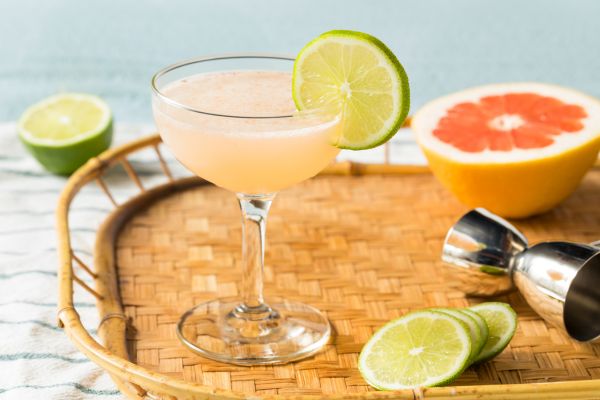
Hemingway preferred his daiquiris “sin azúcar” (without sugar), a nod to both his dislike of sweetness and his battle with diabetes. The bartenders eventually created a custom version just for him: the “Papa Doble”, a frozen daiquiri with double the rum, no sugar, and a splash of grapefruit juice and maraschino liqueur. It became one of the most iconic cocktails associated with his name.
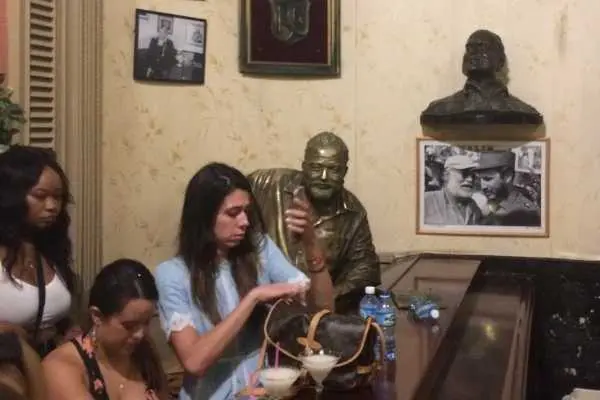
Inside, the bar retains its glamorous 1940s ambiance — complete with polished wood, mirrored walls, red-jacketed bartenders, and live Cuban music. A life-size bronze statue of Hemingway leans on the end of the bar, forever captured mid-drink. Many visitors line up to take photos with “Papa,” whose legacy permeates the room.
Aside from cocktails, El Floridita is a working seafood restaurant and a cultural hub. Walls are filled with vintage photos, newspaper clippings, and memorabilia that paint a vivid picture of Hemingway’s Havana life. Whether you’re sipping a daiquiri or soaking in the vibe, it’s easy to imagine the writer seated in the corner, pen in hand, drink nearby.
4. La Bodeguita del Medio: Where the Mojito Became a Legend
Tucked away on Empedrado Street near Havana Cathedral, La Bodeguita del Medio is a lively, graffiti-covered institution that claims to be the birthplace of the mojito — and another of Hemingway’s most beloved haunts.
Unlike the polished elegance of El Floridita, La Bodeguita exudes a rustic, bohemian energy. The walls are scrawled with signatures and messages from decades of visitors, including actors, presidents, musicians, and, of course, Hemingway himself. Although some debate the authenticity of the famous quote — “My mojito in La Bodeguita, my daiquiri in El Floridita” — it remains carved into the bar’s mythos.

Hemingway visited often, drawn not just by the rum and mint but also by the intellectual and artistic crowd the place attracted. Today, it remains a vibrant hub of Cuban music and social energy, where patrons squeeze into the narrow space to sip mojitos, enjoy live son cubano, and feel the pulse of Havana past and present.
Besides drinks, La Bodeguita also serves traditional Cuban fare, making it a good stop for lunch or a snack between sightseeing. Whether or not Hemingway coined the mojito craze, the spirit of his presence still lingers in every corner — a fusion of literature, rebellion, and good rum.
5. Dos Hermanos Bar: A Lesser-Known Hemingway Hideout
While El Floridita and La Bodeguita del Medio claim most of the spotlight, Bar Dos Hermanos remains one of the more understated — yet equally authentic — Hemingway haunts in Havana. Located near the old Havana port and the Almacenes San José Artisan Market, Dos Hermanos (meaning “Two Brothers”) has been serving drinks and stories since 1894.
This waterfront bar was a popular spot for sailors, dockworkers, and locals — and it appealed to Hemingway’s love for the sea and salt-of-the-earth company. It’s said he would stop in for a drink either before or after his fishing trips aboard the Pilar, especially since the marina was nearby.
With dark wood paneling, vintage photos, and a long polished bar, Dos Hermanos still maintains its old-school charm. There are fewer tourists than at his other famous hangouts, giving it a more relaxed and local feel. The bar’s walls now proudly display photos of Hemingway alongside other famous patrons like Errol Flynn and Marlon Brando.
Though it doesn’t have a cocktail with Hemingway’s name on it, ordering a rum on the rocks or a simple Cuban beer feels true to the spirit of the place — quiet, unpretentious, and steeped in history.
If you’re looking to explore Hemingway’s Cuba beyond the tourist circuit, Dos Hermanos is a must-visit — a place where the echoes of Havana’s past are still very much alive, just as Papa would have liked it.
6. Cojímar: The Fishing Village That Inspired a Masterpiece
To understand The Old Man and the Sea, head east of Havana to Cojímar, a tranquil fishing village that inspired the tale of Santiago and his epic battle with the marlin.
Hemingway frequently fished out of Cojímar and befriended many local fishermen, especially Gregorio Fuentes, widely believed to be the model for Santiago. Though quiet today, the village remains proud of its Hemingway connection. A bust of Hemingway, funded by Cojímar’s fishermen, stands near the water, and visitors can dine on fresh seafood at local paladares (private restaurants), enjoying the same views Hemingway once admired.
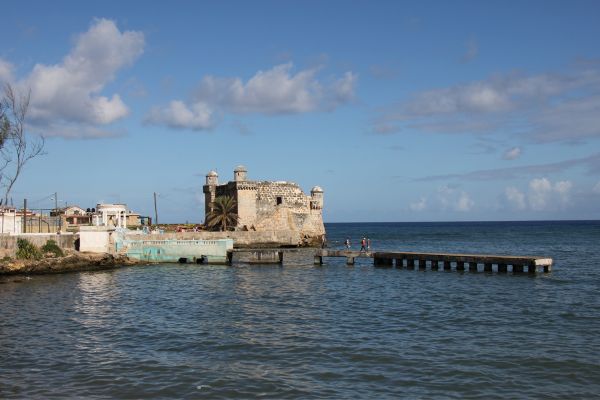
Though small and unassuming, Cojímar offers a handful of meaningful sights for visitors if you’re tracing Hemingway’s footsteps:
- Hemingway Bust: Located on a seaside promenade, this bronze bust of Hemingway was erected by local fishermen in 1962 — just one year after his death. It’s a touching tribute, made from the melted-down propellers of their boats, and stands as a symbol of deep respect and gratitude. You’ll want to take a look at his date of birth on the statue. It’s wrong!
- Cojímar Fort and Waterfront: The 17th-century Spanish fort (Torreón de Cojímar) adds a historical backdrop to the bay. Walk along the malecón for peaceful ocean views and picture-perfect moments. It’s easy to imagine Hemingway setting out from this very shore aboard Pilar.
- Local Paladares (Private Restaurants): Several family-run eateries offer fresh seafood with views of the water. Try La Terraza de Cojímar, a restaurant Hemingway once frequented, for its nostalgic atmosphere and delicious Cuban fare.
- Fishing Boats and Marina: The small marina and colorful boats still used by local fishermen evoke the scenes of The Old Man and the Sea. While simple, the area maintains a timeless charm — perfect for photos or quiet reflection.
Visiting Cojímar isn’t about tourist attractions — it’s about slowing down and experiencing the place much like Hemingway did: with respect for its people, its sea, and its stories. Perhaps if you come here, you’ll get a little inspiration and write your travel memoirs.
Hemingway’s Literary Legacy in Cuba
Despite political shifts over the decades, Hemingway’s legacy in Cuba endures. His home is now the Museo Hemingway, carefully maintained by Cuban authorities. In Havana, bookshops proudly display his works, and literary tours retrace his movements across the city.
In 2022, restoration efforts received international support, reaffirming the commitment to preserving Hemingway’s Cuban story. The bridge between Hemingway and Cuba is not just historical — it’s actively nurtured by those who understand his influence on both literature and Cuban identity.
Travel Tips for Hemingway Enthusiasts
If you’re planning a trip to experience Hemingway’s Cuba firsthand, here are a few tips:
- When to Go: November through April offers the best weather with cooler temperatures and minimal rain. There’s more here on the best time to visit Cuba.
- Getting Around: Use a local guide or literary-themed tour to access historical sites with richer context.
- Support Local: Eat at family-run restaurants, book local accommodations, and purchase from independent vendors to directly benefit Cuban communities. (American visitors should read my guide to visiting on the OFAC category of Support for the Cuban People)
- Respect Preservation: At Finca Vigía and other heritage sites, follow all visitor guidelines to help preserve them for future generations.
CUBA TRAVEL RESOURCES
CUBA BY BUS EBOOK
Buy our Ebook. Preplanned itineraries, themed routes, exact instructions for an easy visit.
Buy Cuba by Bus
BEST
CASA PARTICULARS
See choices here
Luxury rooms? Budget rooms? Laundry? Best room choice & Great hosts.
TOURS & ATTRACTIONS
Top daytrips, small group tours, tickets, pay online easily with free cancellation and top local guides.
Top options here.
TRANSFERS & TAXIS
Read my Guide
Go from A to B easily. Sightsee along the way. Maximise your time in Cuba. Book early for more options.
Final Words on Visiting Hemingway’s Cuba
Few writers are as closely tied to a place as Ernest Hemingway is to Cuba. Known to locals simply as “Papa,” Hemingway lived on the island for nearly 20 years, writing some of his most iconic works surrounded by the tropical heat, sea breezes, and the rhythm of Cuban life. Today, travelers from around the world trace his steps through Havana and beyond, uncovering the places and people that inspired his stories. Exploring Hemingway’s Cuba is more than just literary tourism — it’s a journey into history, culture, and the enduring spirit of a legendary writer.
Cuba’s Best is a participant in the Amazon Services LLC Associates Program, an affiliate advertising program designed to provide a means for sites to earn advertising fees by advertising and linking to amazon.com, amazon.co.uk, amazon.ca. Amazon and the Amazon logo are trademarks of Amazon.com, Inc. or its affiliates.
